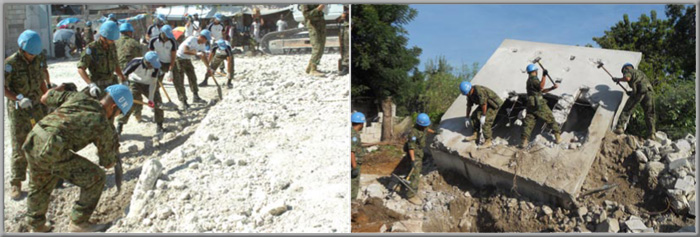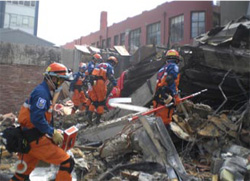Home > Highlighting JAPAN > Highlighting Japan MARCH 2011 > JSDF—Disaster Relief for Haiti
Highlighting JAPAN
COVER STORY: Human Security—The Pursuit of Peace and Happiness
Caption: Members of the Japan Self-Defense Forces at work in Haiti
Credit: COURTESY OF THE MINISTRY OF DEFENCE
JSDF—Disaster Relief for Haiti

JSDF members took time out to play with displaced children in Haiti, and even taught a little Japanese.
Credit: COURTESY OF THE MINISTRY OF DEFENCE
Immediately after the earthquake, the Japan Self-Defense Forces entered Haiti to conduct international disaster relief operations, helping to transport refugees to safe locations and offering medical assistance. From February the same year, a unit engaged in recovery work of the country began its peacekeeping operations under the United Nations Stabilization Mission in Haiti.
In the capital, Port-au-Prince, rubble from collapsed buildings covered the ground following the earthquake, often blocking roads. Approximately 350 members of the Self-Defense Forces' Engineering Unit worked to remove rubble, restore roads, and build refugee camps and orphanages. The city, quiescent when the Self-Defense Forces arrived, quickly saw the return of human and vehicle activity once the rubble was removed and the roads restored.
"Looking from the truck on the way to our work site, I felt the city gradually regain its bustle," recalls Yasushi Kawahara, sergeant first class of the Japan Ground Self-Defense Force's Northern Army Engineer Unit Tunnel Company, who entered Haiti on February 2010 and was involved in recovery work until September the same year.
"I sensed the strength of the people, as they worked diligently towards recovery, thinking about the future instead of losing heart and strength over the destruction from the earthquake."
Sergeant First Class Kawahara said that he was seeing exchange develop with the local people as they proceeded with their operations. The troops learned the local words for "hello" and "thank you" from their Haitian word list and talked to the local people using body gestures. The local people who watched the Self-Defense Forces work also began approaching the troops to talk. The unit gradually began encountering people who would ask how the unit would use certain heavy machinery that the Self足Defense Forces brought with them, or who would ask to have debris in a certain area removed.
"What was encouraging were the words of appreciation from the local people, like 'Thank you' and 'You saved us,'" says Kawahara. "We once had a local person who supplied us with fruit while we were working. I was touched that somebody would care for us like that in a stricken site."
Safety First
"We paid particular care to work that used heavy machinery," recalls First Lieutenant Takanori Iri, former platoon leader of the Tunnel Company. "When we were dismantling damaged buildings with heavy machinery, there were times when a part of the building we never thought would collapse came down. I focused on determining which parts to demolish in what order with extreme care, giving out detailed commands so as to avoid damaging surrounding buildings and to ensure the safety of my men."
The Self-Defense Forces' reconstruction support efforts continue to this day. Since the earthquake, approximately 900 Force members have participated in the reconstruction support efforts to February of this year.
First Lieutenant Iri says he worries constantly about how Haiti is doing, even after his return to Japan. "I would love to participate in the operation again if I ever have the chance."

JDR team members at work in Christchurch, New Zealand
Credit: COURTESY OF JDR
JDR Team in Christchurch
In response to a request from the government of New Zealand, Japan dispatched a Japan Disaster Relief (JDR) team to Christchurch on February 23 following the magnitude 6.3 earthquake of February 22. The team comprised sixty-six rescue workers in total, including doctors and nurses, a structural damage assessor and coordinators, as well as three rescue dogs. The team arrived in the devastated area on February 24 and, in cooperation with the rescue team from New Zealand, immediately set to work on rescue operations at a collapsed building in which over 100 people were believed to be trapped.© 2009 Cabinet Office, Government of Japan






